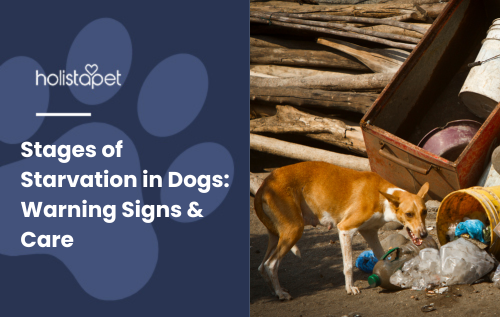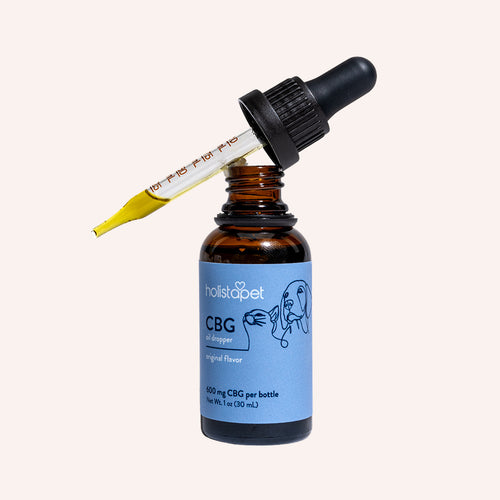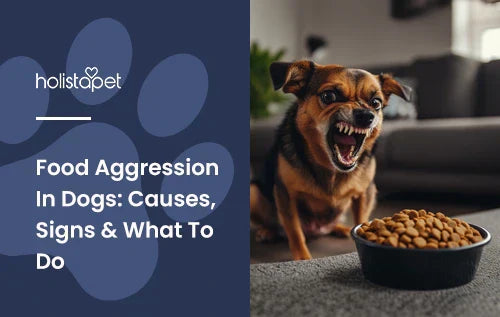Dogs are known for their endless energy and tail-wagging excitement, but what happens when their body weight starts dropping and their ribs become more visible?
The stages of starvation in dogs don't happen overnight. It's a slow and dangerous decline that affects everything from muscle mass to the immune system.
A malnourished dog faces serious risks, including muscle weakness, digestive issues, and impaired immune systems. Keep reading to spot the early signs and find ways to help dogs bounce back.
What Causes Starvation in Dogs?

Dogs need nutritious food to stay strong and maintain a healthy weight. When they do not eat enough, their body weight drops and their immune system weakens. Some dogs struggle due to neglect or lack of pet food, while others have health conditions that prevent them from absorbing essential nutrients.
A low-quality diet can also lead to weight loss, muscle weakness, and other health conditions. If a dog does not get the proper nutrients, it becomes harder for their body to function, making them more vulnerable to illness.
Inadequate Food Intake
Not getting enough food is a major problem. Some dogs are neglected, while others face competition for pet food in multi-dog households. A poor diet lacking proper nutrients causes a drop in body weight and loss of muscle mass.
As their body condition score declines, they lose energy and strength. A steady supply of nutritious food is necessary to keep a dog active, maintain their dog's health, and prevent starvation.
Medical Conditions Leading to Starvation
Some dogs eat regularly but still lose weight. Certain health conditions make it hard for their body to use essential nutrients properly. Problems like diabetic ketoacidosis, gastrointestinal issues, and hepatic lipidosis interfere with digestion, causing muscle weakness and weight loss.
These conditions can also lower insulin secretion, affecting how the body processes fatty acids and protein stores. If a dog is eating but losing weight, veterinary care is needed to find the cause and create a treatment plan.
Extended or Severe Stress and Anxiety
Stress can have a huge impact on appetite. Dogs that feel anxious often refuse to eat, leading to muscle weakness, weight loss, and a weakened immune system. Triggers like loud noises, frequent changes, or separation from their owner can disrupt their eating habits.
A nervous dog may avoid food, causing their body weight to drop. Keeping their environment calm and reassuring can help them regain their appetite and stay at a healthy weight.
Recognizing the Early Starvation Stages in Dogs

Dogs do not become emaciated overnight. A malnourished dog may show mild symptoms in the beginning, which can be easy to miss. A malnourished dog may seem tired, lose interest in food, or act differently than usual. As their body weight drops, their muscle mass shrinks, and their immune system weakens.
Catching these warning signs early can help pet owners take action before serious health problems develop. The next sections cover key symptoms to watch for.
Decreased Energy and Lethargy
A healthy dog is always ready for a walk, a game of fetch, or a belly rub. When a dog starts losing energy and becomes sluggish, it can be an early sign of weight loss and malnutrition. Without essential nutrients, their body struggles to maintain fat and protein levels, leading to muscle weakness. This makes simple activities exhausting.
A dog that once ran to greet you might now stay curled up, uninterested in playtime. Paying attention to these changes can help prevent further health complications.
Changes in Behavior and Appetite
A dog's love for food is usually strong, but a malnourished dog may refuse to eat or become picky. Their appetite might decrease, or they may start searching for scraps in unusual places. At the same time, their behavior can shift. A once friendly pup may seem irritable or withdrawn.
These changes often happen when the body condition score drops, affecting dog's health and mood. If a dog is eating less or acting strangely, a feeding plan with nutritious food can help restore balance.
Related Post: How Long Can a Dog Go Without Eating?
Identifying Advanced Starvation Stages in Dogs
When starvation reaches advanced stages, the signs become impossible to ignore. A malnourished dog will have visible rib bones, extreme weight loss, and a frail body with little body fat left. Their muscle mass shrinks, making movement difficult, and their immune system struggles to fight infections.
At this point, a dog's body condition score is dangerously low. Without immediate nutritious food and veterinary care, the risk of organ damage increases. Recognizing these signs quickly is key to preventing permanent harm.
Severe Weight Loss and Emaciation
A healthy dog has a strong frame and steady body weight, but a starved animal looks fragile and weak. When weight loss reaches an extreme level, their rib bones, hip bones, and spine become more visible. The body burns through fat and protein stores for energy, causing severe muscle weakness.
An emaciated dog may struggle to walk, shiver due to low body temperature, or lose fur from skin issues. At this stage, urgent intervention with a recovery diet is critical for survival.
Organ Failure and Heart Issues
As starvation continues, the body's ability to function starts shutting down. A lack of essential nutrients leads to heart problems, poor circulation, and weak red blood cells. A lack of essential nutrients lowers the metabolic rate, putting strain on the liver and kidneys.
Conditions like hepatic lipidosis and electrolyte imbalances develop, putting extreme strain on the heart. Dogs in this condition need immediate fluid therapy, feeding plans, and closely monitored veterinary care to have any chance of recovery.
How to Help a Starving Dog
A malnourished dog needs more than just a big meal. The body has been in survival mode, making sudden weight gain risky. Feeding too much too fast can cause digestive issues and serious complications. Instead, helping a starved animal recover takes patience, the right nutritious food, and a careful feeding plan.
Slowly introducing essential nutrients and monitoring their dog's health ensures a safe recovery. The next sections explain the best approach to safely restoring a dog's body weight and strength.
Gradual Refeeding to Avoid Refeeding Syndrome
A starving dog cannot handle large meals right away. Their body has adapted to survival by slowing insulin secretion and using fat and protein for energy. Feeding too much too quickly can cause refeeding syndrome, a dangerous shift in fluids and minerals that can lead to electrolyte imbalances and organ failure.
The best approach is small meals packed with essential nutrients, given throughout the day. Pet owners should watch their dog’s progress and consult a vet to fine-tune the feeding plan for a smooth recovery.
Transitioning to a Nutritious Diet
Once a dog can tolerate food again, the next step is ensuring they get the right balance of proper nutrients. A diet rich in fatty acids, protein stores, and essential nutrients helps rebuild muscle mass and restore dog's health. Changing from a basic starter diet to nutritious pet food needs to be done step by step to keep digestion on track.
Providing nutritious food in controlled portions supports steady weight gain and prevents complications. Careful feeding helps a malnourished dog regain strength without overwhelming their system.
Weight Gain and Muscle-Building Supplements
A malnourished dog needs more than just extra pet food to regain strength. Their body has lost muscle mass, fat, and essential nutrients, making it harder to recover. Supplements help rebuild muscle strength, support weight gain, and boost overall health while making the recovery process smoother. Here is a great option:
-
Muscle Support Soft Chews for Dogs. These chews are packed with dimethylglycine (DMG), lysine, L-carnitine, and potassium chloride, which help rebuild muscle mass and improve energy levels. Dogs recovering from weight loss need extra support to regain their strength. The peanut butter and banana flavor makes these chews a delicious way to help dogs feel stronger and more active.
Appetite Stimulants and CBD
Getting a dog to eat again is one of the biggest challenges after weight loss. Some dogs lose interest in food, while others have digestive trouble or stress that makes eating difficult. CBD and other appetite stimulants may help promote an appetite, calm the stomach, and support digestion. Here's some of our top options.
- CBD Wellness Dog Treats. These treats contain broad-spectrum CBD oil, which may relax the digestive system and encourage eating. Made with real blueberries and sweet potatoes, they offer support while promoting a healthy weight.
- CBD Oil for Dogs. For dogs that need fast-acting appetite support, CBD oil may be a great option. Adding it to their food may help support digestion and make eating more enticing. It may also support a calm mind, which can help if stress is the reason behind their lost appetite.
- Probiotics for Dogs Soft Chews. Good gut health helps support appetite and keeps digestion running smoothly. These probiotic chews promote balance in the digestive tract, potentially helping dogs absorb essential nutrients more efficiently. Probiotics may also ease digestive issues, making meals easier to tolerate for dogs struggling to eat.
Preventing Starvation in Dogs

The best way to stop stages of starvation in dogs is through proper care, nutritious food, and routine checkups. A healthy dog needs a steady diet, low stress, and consistent feeding habits. These simple steps help pet owners keep their dogs at a healthy weight and in good shape.
- Maintaining a Consistent Feeding Schedule. Dogs need regular meals to keep their body weight stable. A set feeding routine prevents missed meals and supports steady digestion. Providing proper nutrients at the same time each day helps avoid weight loss and keeps their dog's health in check.
- Managing Stress and Anxiety. A stressed dog may stop eating, leading to muscle weakness and other health problems. Reducing loud noises, offering a safe space, and using calming aids can help. A relaxed dog has a more balanced metabolic rate and a stronger immune system.
- Regular Veterinary Check-Ups. Some health conditions affect appetite and digestion. Routine vet visits catch problems early and prevent weight loss and digestive issues. A vet can check a dog's body condition score and recommend a feeding plan for better overall health.
When to Seek Veterinary Help for a Starving Dog

Some signs show a dog needs urgent veterinary care. If a dog has any of these symptoms, immediate action is necessary.
-
Severe weight loss with visible rib bones and muscle loss
-
Lack of appetite and refusing pet food for a prolonged period
-
Weakness and fatigue with trouble standing or moving
-
Digestive issues like vomiting, diarrhea, or gastrointestinal problems
-
Swelling or bloating with an expanded abdomen
-
Dull coat and skin problems with hair loss, skin issues, and bad breath
-
Signs of organ failure like labored breathing, discolored gums, or seizures
A treatment plan with fluid therapy, small meals, and closely monitored care is critical for recovery.
Final Thoughts: Starvation Stages in Dogs
Catching the stages of starvation in dogs early can save lives. A healthy dog needs steady meals, nutritious food, and regular care to stay strong. If you notice weight loss, muscle weakness, or a lack of appetite, take action fast.
A proper diet, a stress-free environment, and routine vet visits help prevent serious health problems. HolistaPet offers CBD treats, muscle support chews, and wellness products to keep dogs and cats in top shape. Adding high-quality supplements to their feeding plan ensures they get the proper nutrients they need to live a happy, active life.
Read more dog care articles


 CBD Oil for Dogs - Fast Acting
CBD Oil for Dogs - Fast Acting
 Chicken Flavored CBD Oil For Dogs - Easy Dose
Chicken Flavored CBD Oil For Dogs - Easy Dose
 Salmon Flavored CBD Oil For Dogs - Highly Rated
Salmon Flavored CBD Oil For Dogs - Highly Rated
 CBG Oil for Dogs and Cats - Loved by Thousands
CBG Oil for Dogs and Cats - Loved by Thousands





Leave a comment
All comments are moderated before being published.
This site is protected by hCaptcha and the hCaptcha Privacy Policy and Terms of Service apply.